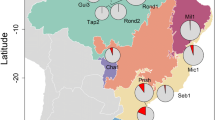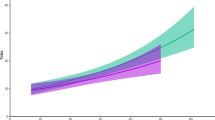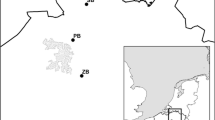Summary
Two Australian tick species Aponomma hydrosauri and Amblyomma albolimbatum have the same major host species, the lizard Trachydosaurus rugosus. While females of Amb. albolimbatum are most often attached in the ears and on the neck of their hosts, Ap. hydrosauri females prefer to attach further back, under the forearms and on the back. Males show the same interspecific difference but there is also a difference between populations. Ap. hydrosauri males from populations in contact with Amb. albolimbatum attach more often in posterior positions than Ap. hydrosauri males from populations isolated from Amb. albolimbatum. These differences were found in both field populations and laboratory reared ticks. Phylogenetic evidence suggests that the change in male attachment site between Ap. hydrosauri populations followed the colonization of T. rugosus. We propose that the most likely reason for the change of attachment sites has been interspecific interactions with Amb. albolimbatum and that competition has been for space for efficient reception of female signals.
Similar content being viewed by others
References
Andrews RH (1981) The mating behaviour of three parapatric species of reptile tick. Ph.D. Thesis, The Flinders University of South Australia
Andrews RH, Bull CM (1980) Mating behaviour in the Australian reptile tick Aponomma hydrosauri. Anim Behav 28:1280–1286
Andrews RH, Bull CM (1981) Inhibition of mating behaviour before feeding in the tick Aponomma hydrosauri. Anim Behav 29:518–522
Andrews RH, Bull CM (1982) An attractant pheromone with common properties in three reptile ticks. Experientia 38:99–100
Andrews RH, Petney TN (1981) Competition for sites of attachment to hosts in three parapatric species of reptile tick. Oecologia (Berlin) 51:227–232
Brooks DR (1980) Allopatric speciation and non-interactive parasite community structure. Syst Zool 29:192–203
Bull CM (1978) Heterogeneity of resource utilization in a population of the Australian reptile tick, Aponomma hydrosauri (Denny). Ecol Entomol 3:171–179
Bull CM, King DR (1981) A parapatric boundary between two species of reptile ticks in the Albany area, Western Australia. Trans R Soc South Aust 105:205–208
Glauert L (1961) A handbook of the lizards of Western Australia. Western Australian Naturalists Club, Perth
Holmes JC (1973) Site selection by parasitic helminths: interspecific interactions, site segregation, and their importance to the development of helminth communities. Can J Zool 51:333–347
Holmes JC, Price PW (1980) Parasite communities: The roles of phylogeny and ecology. Syst Zool 29:203–213
Kaufman T (1972) A revision of the genus Aponomma Neumann, 1899 (Acarina: Ixodidae). Ph.D. Thesis, University of Maryland
Price PW (1980) Evolutionary biology of parasites. Princeton University Press, Princeton, New Jersey
Rohde K (1979) A critical evaluation of intrinsic and extrinsic factors responsible for niche restriction in parasites. Am Nat 114:648–671
Roberts FHS (1970) Australian ticks. CSIRO, Melbourne
Sharrad RD (1980) Studies of the factors which determine the distributions of three species of South Australian ticks. Ph.D. Thesis, University of Adelaide
Sharrad RD, King DR (1981) The geographical distribution of reptile ticks in Western Australia. Aust J Zool 29:861–873
Smyth M (1973) The distribution of three species of reptile ticks, Aponomma hydrosauri (Denny), Amblyomma albolimbatum Neumann, and Amb. limbatum Neumann. I. Distribution and host. Aust J Zool 21:91–101
Author information
Authors and Affiliations
Rights and permissions
About this article
Cite this article
Andrews, R.H., Petney, T.N. & Bull, C.M. Niche changes between parasite populations: An example from ticks on reptiles. Oecologia 55, 77–80 (1982). https://doi.org/10.1007/BF00386721
Received:
Issue Date:
DOI: https://doi.org/10.1007/BF00386721




